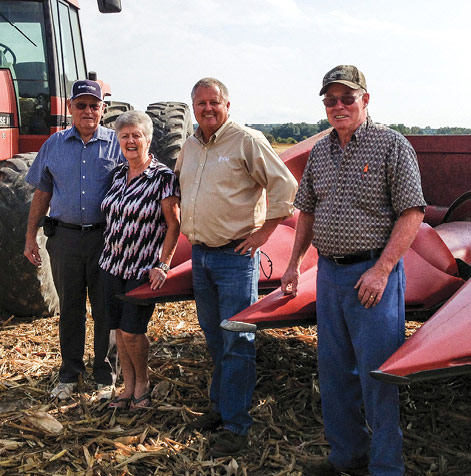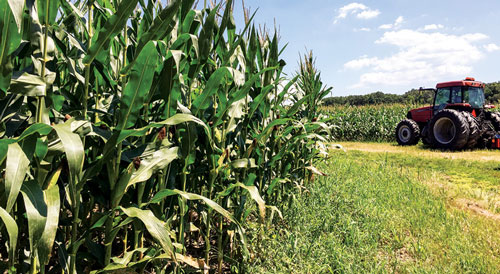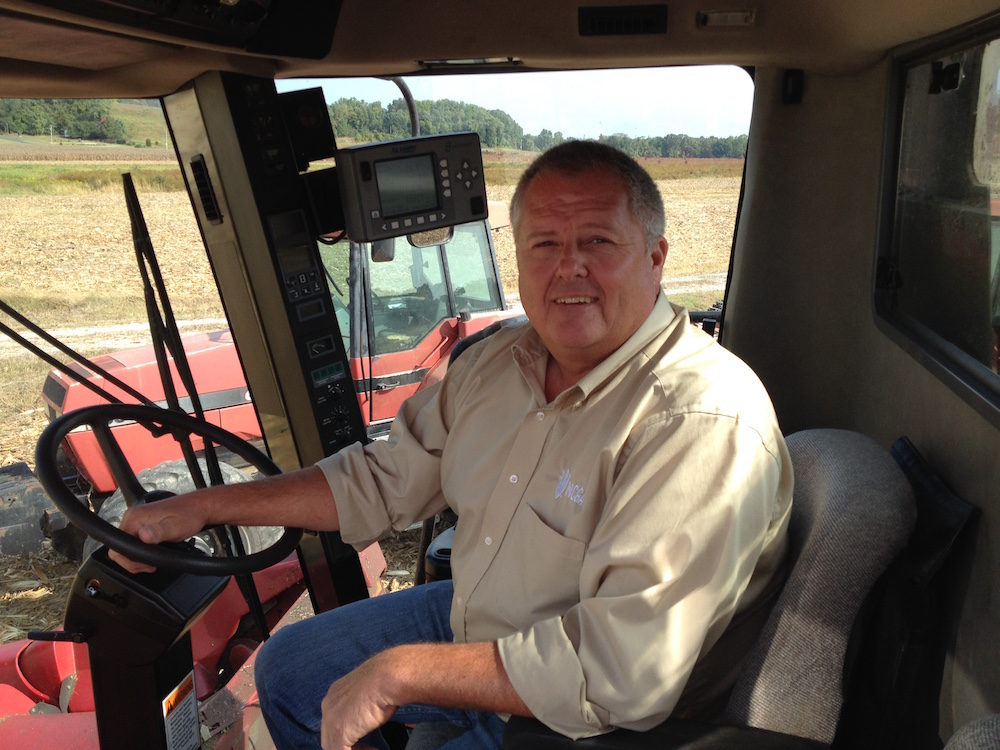Pictured Above: WATER WATCH. Chip Bowling is surrounded by water in the heart of the Chesapeake Bay watershed. His family has long used no-till, cover crops, buffer strips and nutrient management plans to keep soils and nutrients in place.
Check The Specs...
NAME: Chip Bowling
LOCATION: Newburg, Md.
YEARS NO-TILLING: 30
ACRES: 1,600
CROPS: Corn, soybeans and wheat
I LOOK AT water every day from my fields. I farm right on the Maryland-Virginia border. The only thing separating me from Virginia is the Potomac river. This puts my farm right in the heart of the Chesapeake and Zekiah watersheds. We’re also on the Wicomico River, which is 11 miles long and seeps into the Potomac river. All of the water from our farm ends up in the Chesapeake Bay.
What does that mean for us? Well, a lot of regulation when it comes to how we farm. It was a hassle at first — and people cringe when I say this — but I think the regulations have possibly made us better nutrient managers. We’re more aware of our fertilizer use and how it’s working for us. I’m also more environmentally sensitive.

(l-r) Charles and Betty Bowling, Chip Bowling and employee Bill Higgs.
Long before our nutrient and fertility use was mandated, my family was already making strides in conservation. Going way back, my family has actively been using cover crops since the 1940s. We seeded them on every tobacco acre we had as tobacco was a heavily tilled crop. You would moldboard plow it and then cultivate it multiple times per year. This made the soil very vulnerable so my grandfather would use cover crops to secure it.
We get a lot of heavy rains, often the product of tropical storms and hurricanes, which also can cause huge problems with soil erosion. My family was very aware of the damage of soil erosion both to our farm and the environment. They wanted to keep the soils on our fields and out of the rivers. Since almost every acre we farm is right next to a river, we grew cover crops to help hold the soil. We also had cattle at the time, so we grazed the cover crops all winter long.
We no longer grow tobacco or raise livestock, but we’ve continued our use of cover crops as we’ve seen the benefit they have on our soils and for nutrient management. No-till was another conservation tool we picked up along the way. In the mid-1980s we could see farming practices were changing. No-till was appealing because we saw we could save time and fuel, cut down on nutrient loss and keep our soils in place.
The first couple of years we started no-tilling we did see a little yield drag, but about the fifth year in our soils started to change, organic matter was increasing and our fields started to thrive in the no-till system. I haven’t used a plow or disc in the 15 years since.
Iron Exceptions
I’m not completely against using some iron in my fields, though. It just should be the right kind of tool. We do some vertical or conservation tillage with a Case IH True-Tandem 330 Turbo Till conservation tillage implement. It has two rows of wavy coulters followed up by a rolling basket. I use it to go very lightly over my fields in early spring, breaking up the residue and the top 2-inch crust of the soil to warm and dry it up ahead of planting.
Our weather settles into a very hot and dry pattern in July. We want to get our corn planted early to make sure it has tasseled and pollinated before we get to that weather. To hit that mark, we need to be planting corn around March 20. But, our springs are typically very wet, which is where the TurboTill comes in on acres where cold, wet soils are problematic. Generally, our sandy fields will dry up fine, but some of our river bottoms with more topsoil need that extra push. Usually we’re able to TurboTill and then no-till plant the corn in 2 to 3 days.
We don’t always use the TurboTill, though. If we have a warm winter and average moisture, we might just wait a couple extra days, not disturb the residue, and go completely no-till.
Forced Hand
Cover crops and no-till are old hat for us at this point. A more recent change is our intensified focus on nutrient management, as mandated by the EPA to protect the Chesapeake Bay. The goal of the mandate was to decrease nitrogen (N), phosphorus (P) and sediment entering the Chesapeake Bay. To achieve this goal, they began monitoring and regulating our use of N and P in our fields through nutrient management plans. My biggest issue with the nutrient management plan in the early days was that it was mandated. I wish we would have had the chance to voluntarily tackle the issue instead of jumping straight to regulation. I think there would have been wider acceptance.
In our program, we’re only allowed a certain amount of N and P each year. The amount is determined by past yields and balanced out by how much of each is available in the soil. We soil test every field — or depending on field size, every 40 acres — every year. Soil samples are gathered form different places each year to make sure our data represents what’s happening in the entire field.
Years ago, we would soil test every 3 years. Then when the mandate came into effect in 1998 we started soil testing every year. More frequent soil testing taught us a few things. For one, in years past when crops looked a little yellow, farmers would put on more fertilizer. We found out if you put out the fertilizer prescription and Mother Nature gives you the right amount of moisture and temperature that you will get a good crop. You don’t need to pour on more fertilizer. We became more patient with our fertilizer use. We were pretty in-tune with our fields so it didn’t change much for us, but it gave us confidence that we were applying the fertility we needed at the right time in the right place. It also showed that cover crops do help hold onto nutrients from season to season.
Each field gets a different prescription. We stopped raising tobacco in 1999, but those fields still measure high in P so they usually don’t get any additional applied. I apply N up to four times per year in corn. First, I’ll broadcast some fertilizer with N the day before I plant. I apply a little more N when I spray my residual herbicide shortly after planting. I then top-dress or sidedress up to two times during the summer. I often do an in-season tissue test to determine if more N is needed. If that test shows something is missing, I can also get my nutrient management plan amended to allow for additional inputs.
It’s a few extra steps, but now it’s just part of business as usual and helps us make sure the inputs we’re buying are being put to good use. I will say the Chesapeake Bay got the best water grade this past year that it’s had since the nutrient management plan was put in place. As farmers, we’ve reached 125% of our goals and the water quality has only increased 10-15%. This has helped show that our urban and suburban neighbors shoulder a more significant part of the problem than initially thought.
I’ve been very active with the National Corn Growers pushing their Soil Health Partnership initiative in the hopes of helping other farmers avoid a situation where regulations force them into certain practices. The idea is to approach soil health and nutrient management voluntarily. Farmers need to be proactive in this department, not reactive. The Soil Health Partnership gives them a way to voluntarily put their farms into a plan similar to the ones we follow in Maryland. We have up to 100 farmers across multiple Midwestern states who are participating. I think just even getting used to keeping data will be an important part in helping farmers along the Mississippi river and Gulf states avoid ending up in a mandatory program. Once we have data, the numbers are easy to defend.
Wheat Cover
Though we no longer raise tobacco or till our soils, we still have a place for cover crops on our farm. In fact, we try to get a cover crop on nearly every acre every year. It’s another layer of protection to help us keep our soil in place, which also serves to protect our water resource.
In my current cropping system, I expect my cover crop to not only hold soil, but to pick up and hold any extra nutrients that are in the soil. Our cover crop of choice is winter wheat. We’ll sometimes use cereal rye, but 95% of the time we stick with wheat. Corn harvest starts in early September and we seed the cover crop right behind the combine. I’ve tried a lot of methods, but have settled on broadcasting 2¼ bushels of wheat per acre and then making a light pass with the TurboTill to get good seed to soil contact. This seems to work very well for us and there hasn’t been a noticeable difference from drilling it.
In the Mid-Atlantic area we can effectively seed cover crops well into November without fear of frost. Our cover crop wheat is usually about 1 foot tall by the time it gets cold enough in December to shut it down. It might even grow a little bit throughout the winter and by spring is approaching 18 inches tall. I’ll burn it down with Roundup and let it die completely before planting. I don’t want the wheat to get too tall.
One reason we use wheat as a cover crop is we also grow winter wheat as a crop. We get our wheat certified so we’re able to hold back seed to plant for a cover crop, which saves us from another purchase. Even without that advantage, cover crops are an economic choice as Maryland has a cost share program for planting cover crops as part of the Chesapeake Bay watershed program. My fellow farmers and I plant about 500,000 acres of cover crops in Maryland and it seems to be growing every year. The Chesapeake Bay mandate has really helped shift our farmers’ state of mind about no-till, cover crops and other conservation practices.
Triple Play
Where we have wheat in our rotation we will harvest in June and double crop soybeans. We like having wheat in our rotation as it adds more diversity and our soybean yields behind wheat are just as good and often even better than our other soybeans. We’re able to keep seed for cover crops, so we get three paychecks from those fields in a year—one for soybeans, one for milling wheat—there’s a good market for wheat for chicken feed and bakeries in the area—and one for seed wheat. We also harvest all the straw.
In the past I’ve drilled my wheat in 7.5-inch rows, but the last couple of years we’ve gone to broadcasting and incorporating it with the TurboTill just like our cover crop wheat. We use a 2¾-bushel seeding rate when planting for harvest as compared to cover crop rates. I’ve seen no difference in yield or quality using this method and I can cover twice as many acres per day. In fact, last year I planted my entire wheat crop in one pass using the TurboTill and a spreader. There’s a lot less maintenance with the TurboTill as opposed to the drill, too. I really don’t see any difference other than you don’t see uniform rows. I still average about 70-bushel wheat.
Once the wheat is harvested we go back in with our Kinze 3600 no-till planter with an interplant to seed soybeans in 15-inch rows. I use Yetter row cleaners that I set just aggressively enough to clear the residue in front of the opening wheel. A wavy no-till coulter runs in front of the opener preparing a 2-inch-2 wide path to improve seed-to-soil contact. I have the pneumatic down pressure system that keeps just the right amount of pressure on each row no matter the conditions.
One beneficial change I’ve made in my soybean management is I now do an in-season application of liquid fertilizer. I’ve found it to be a more efficient use of the fertilizer because I’m spraying it on the growing plant and it is absorbed through the leaves. It’s also a more precise timing of when the plant needs the fertilizer and helps me adhere to the nutrient management plan.

RIGHT TIME. Up to four separate N applications are used to feed Chip Bowling’s corn crop. He says nutrient management plans have helped him be more aware of his fertilizer use and helped guide improvements in his fertility program.
When my soybeans produce a good canopy and I can no longer see down the rows, I’ll apply the mixture of P, potash, and micronutrients. It’s a foliar mix I get through my local Southern States Cooperative. I’ve been doing this for the last 6 years and I consistently get a 6- to 10-bushel yield bump. Plus, I’m actually using less fertilizer. On soybeans, I’m not putting out any granular fertilizer. It’s all foliar.
Part of why my soybeans don’t get granular fertilizer is because of my crop rotation, too. Soybeans following corn are getting some residual from the nutrients I applied to the corn. On the acres where I’m growing wheat I only make one pass so there’s residual and I get two crops out of one fertilizer pass. We’re trying to keep fertility up in our fields so there’s always plenty to grow a crop. The nutrient management plan helps us to track and manage those levels.
Dicamba Rescue
There’s a tremendous number of genetic and trait combinations available for us to use in our fields to fit our needs. This past year, we tapped into Roundup Ready 2 Xtend soybeans to solve a tough problem. About 4 years ago we started to get some resistant Palmer amaranth in the area. Then, it exploded. It went from a few plants here and there to nearly all our fields having resistant weeds. We had to do something, so this year we planted 100% of our soybean acres to the new dicamba tolerant soybeans.
I do all my own spraying. I’m also surrounded by a lot of homes with very nice landscaping. I wanted to be very cautious of drift, so when it came time to use the Dicamba, I changed out my spray tips for TeeJet TTi04 low-drift tips. When I’m spraying Roundup or an atrazine herbicide I normally operate my RoGator self-propelled sprayer at around 9 to 11 mph. For Dicamba application I slowed down to 6 to 7.5 mph depending on conditions. I also used the XtendiMax herbicide with VaporGrip technology to further help the herbicide to stick to the plant and avoid drift issues.
I was thrilled that not only did I have zero drift problems, but my fields are unbelievably clean. When I go to harvest, I’ll keep a keen eye out from the combine to see just how complete my control was. My plan is to continue with the system for a couple of years to completely eradicate the resistant Palmer amaranth. This soybean variety also had some new traits that are supposed to give it a yield bump, but I won’t know how that worked out until harvest.








Post a comment
Report Abusive Comment